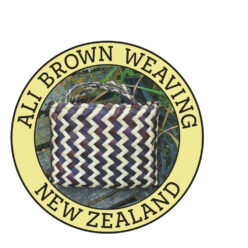9 May 2012
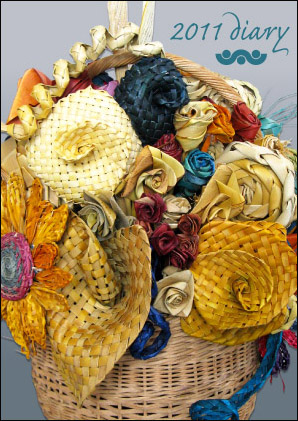 Creative Fibre — once known as the New Zealand Spinning, Weaving & Woolcrafts Society — seems to be evolving from a focus on traditional woven woolcrafts to encompass flax, felt, free-form designs and any and every use of fibre for creative purposes. Last year’s Creative Fibre diary featured a basket of my flax flowers on its cover and this year I was invited to give two demonstrations of flax basket-weaving at the Creative Fibre Festival in Marlborough. It was my first visit to a Creative Fibre Festival, and the whole festival gave off a feeling of creative energy. As I listened to the presenters, I automatically thought of the way the ideas they applied to other fibres could be transferred to the process of flax weaving.
Creative Fibre — once known as the New Zealand Spinning, Weaving & Woolcrafts Society — seems to be evolving from a focus on traditional woven woolcrafts to encompass flax, felt, free-form designs and any and every use of fibre for creative purposes. Last year’s Creative Fibre diary featured a basket of my flax flowers on its cover and this year I was invited to give two demonstrations of flax basket-weaving at the Creative Fibre Festival in Marlborough. It was my first visit to a Creative Fibre Festival, and the whole festival gave off a feeling of creative energy. As I listened to the presenters, I automatically thought of the way the ideas they applied to other fibres could be transferred to the process of flax weaving.
The key guest presenter, Kim Thitichai from the UK, a delightful, energetic speaker, works with heat tools on materials that are heat distressable. Heat stressing doesn’t readily transfer to flax weaving but the key for me in her presentation on design was her discussion about “engaging directly with the materials”. Sometimes, no matter how well we plan things when working creatively, the process doesn’t go according to the plan.
 The materials themselves can dictate the way the project ends up and — if one goes with the flow — the results can be innovative and dramatic. I find myself regularly using this technique when I’m designing though I generally call it playing. A good example of this is the flaxwork Wave pictured above, which I created for an exhibition in the seaside town of Lyttelton. It’s made from a flat woven square of multi-coloured blue flax strips, and although I wasn’t at all sure how it was going to end up, it does seem to capture a sense of the shape and motion of a wave.
The materials themselves can dictate the way the project ends up and — if one goes with the flow — the results can be innovative and dramatic. I find myself regularly using this technique when I’m designing though I generally call it playing. A good example of this is the flaxwork Wave pictured above, which I created for an exhibition in the seaside town of Lyttelton. It’s made from a flat woven square of multi-coloured blue flax strips, and although I wasn’t at all sure how it was going to end up, it does seem to capture a sense of the shape and motion of a wave.
A World of Wearable Arts award winner, Sarah Hornibrooke from Golden Bay, who regularly uses flax in the creations that she enters in the competition, gave some tips for those wishing to enter it. Sarah advises that the garment must be well-made as it is worn in a number of shows and it needs to stay together, as well as being reasonably easy to get on and off.
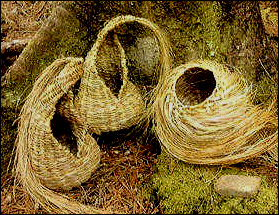 The garment should look good close up and at a distance as the garments are closely scrutinised by the judges, but it also needs to have impact when are worn during the show. Often the winner is a very simple idea. It’s also helpful for the garment to have a catchy name. Deb Price, whose woven flax pots are pictured here, and who often works with Sarah on entries, was the Montana Supreme Award Winner in 1995 with an twined-flax creation, Moko.
The garment should look good close up and at a distance as the garments are closely scrutinised by the judges, but it also needs to have impact when are worn during the show. Often the winner is a very simple idea. It’s also helpful for the garment to have a catchy name. Deb Price, whose woven flax pots are pictured here, and who often works with Sarah on entries, was the Montana Supreme Award Winner in 1995 with an twined-flax creation, Moko.
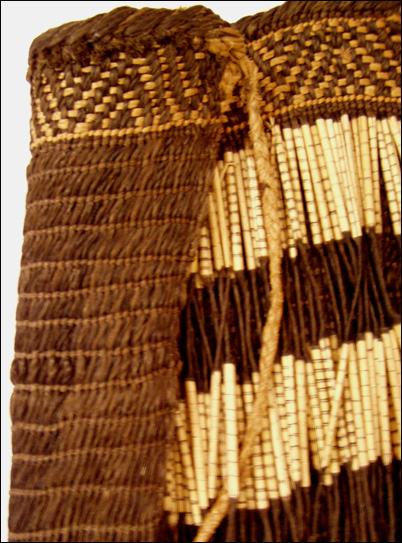 Flax featured in Heather Baskiville-Robinson’s presentation on making paper. Heather took us through the process of making flax paper, and we watched Canadian paper-maker Helen Heibert’s time-lapse DVD on the way that some materials can be their own creators as they change shape over time, a property that Helen specifically exploits in her creations. This has a parallel in flax weaving where two properties of flax have been exploited to make a skirt, or puipui. Firstly, flax strips curl up into cylinders when they dry, a property which is used in puipui-making to make the long rustling skirt of the puipui. Secondly, the fibres inside the flax take a dye more readily than the leaf itself and this property is exploited to make the geometrical patterns on the garments.
Flax featured in Heather Baskiville-Robinson’s presentation on making paper. Heather took us through the process of making flax paper, and we watched Canadian paper-maker Helen Heibert’s time-lapse DVD on the way that some materials can be their own creators as they change shape over time, a property that Helen specifically exploits in her creations. This has a parallel in flax weaving where two properties of flax have been exploited to make a skirt, or puipui. Firstly, flax strips curl up into cylinders when they dry, a property which is used in puipui-making to make the long rustling skirt of the puipui. Secondly, the fibres inside the flax take a dye more readily than the leaf itself and this property is exploited to make the geometrical patterns on the garments.
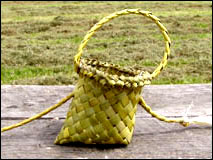 Flax is an ideal material to be creative with, as it is pliable and sculptural while green but hardens to retain shape as it dries. It also has a strong fibre and it dyes well. Traditional weaving techniques can be used to make something a bit out of the ordinary, like my little three-cornered Wind-blown kete.
Flax is an ideal material to be creative with, as it is pliable and sculptural while green but hardens to retain shape as it dries. It also has a strong fibre and it dyes well. Traditional weaving techniques can be used to make something a bit out of the ordinary, like my little three-cornered Wind-blown kete.
Why not think about using flax creatively to enter the Creative Fibre competitions for next year. The Far North Award, sponsored by Te Wananga O Aotearoa, of $750 and a Whaka Huia for the most creative use of New Zealand design or materials seems like a particularly appropriate category for flax weaving. This year’s winner for the Award is Donna Hitchcox of Timaru with her entry Tuatara Wisdom. It would be great to see flax featuring to a greater degree in this competition as well as in the Wearable Arts Awards. If you have used flax in entries for either of these awards, or any other awards, do send me a photo.
© Ali Brown 2012.
Scroll down to leave a new comment or view recent comments.
Also, check out earlier comments received on this blog post when it was hosted on my original website.
